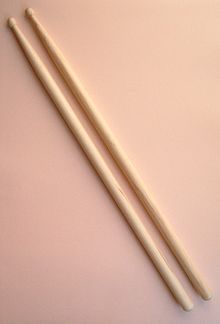Stick (drums)
With the sticks , even drumsticks (singular stick , German floor , mallets ), Drum Stick , Drumstick and drumstick or drumstick , playing drums , drummer and percussionist . There are different designs and sizes, some of which are standardized (2A, 5A, 7B, etc.). Sticks are needed to create tones on percussion instruments . The English term stick is mainly used by drummers, percussionists and percussionists speak of mallets .
General
A stick consists of a 30 to 45 centimeter long shaft with the embroidery head at the tip. Normally, sounds are generated when the embroidery head hits the instrument (e.g. skin ), but the shaft can also be played with. Usually the drummer has a stick in each hand. The way you hold the sticks depends on the technique and style of music .
execution
The sound of the generated tone is particularly dependent on how the stick is handled. That is why the market offers a variety of sticks in different lengths, strengths (diameters), weights, hardnesses, surfaces, profiles and head shapes and head materials. The length of sticks is usually between 38.5 and 42.5 centimeters and their weight varies from 40 to 70 grams. Both dimensions are heavily dependent on the material and design.
material
Sticks are mainly made from wood . Besides Hickory , Oak (Engl. Oak ) and Maple (Maple) also sticks out are hornbeam (Hornbeam) offered or other, mostly exotic wood species. The type of wood has a decisive influence on the sound, the balance and the lifespan of the sticks. As a natural product, wood means that there are sometimes considerable differences in quality and texture within one type of wood. In the past, this sometimes led to different results in production. It was only through modern manufacturing processes that it became possible to produce pairs of embroidery in which the copies are almost identical.
In addition to the conventional material wood, sticks are made from carbon , plastic , laminate and metal (mostly aluminum ). In many models, the shaft and embroidery head are made of different materials, e.g. B. wooden shaft with plastic head.
head
The head shape of a stick largely determines the resulting sound. Since different head shapes always sound different on different media (fur, pelvis, rubber pads, etc.), the selection of the "right" head shape is often a matter of taste. The most common material used for normal embroidery heads is wood; nylon is used less often.
Other designs
Jazz brooms are also used , at the front end of which there are many fine wires or plastic strips. Rod sticks consist of a composite of several thin wooden sticks and produce a soft sound that lies between jazz brooms and classic drum sticks. Mallets create the sound with a head made of felt , cork , rubber or yarn .
Timpani are played with mallets that have large balls of felt or fabric on top.
Well-known embroidery manufacturers
- Millennium
- 3 drumsticks ( drum workshop )
- Agner
- Ahead
- Aquarian
- Artbeat
- B-stick
- Balbex
- ice-stix
- Lefima
- Paiste
- Pell Wood
- Promark
- Shelf tip
- Rohema (The German Drumstick)
- Sonorous
- Schulz Equipment
- Stagg
- StarWood
- Tama
- father
- Vic Firth
- Zildjian


